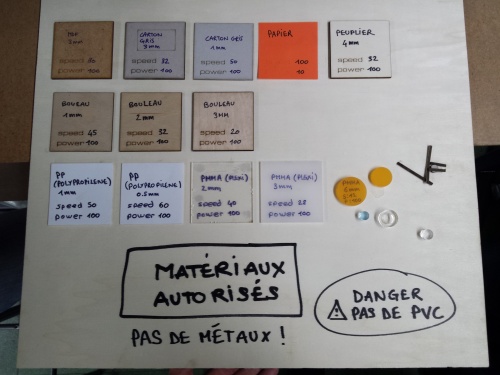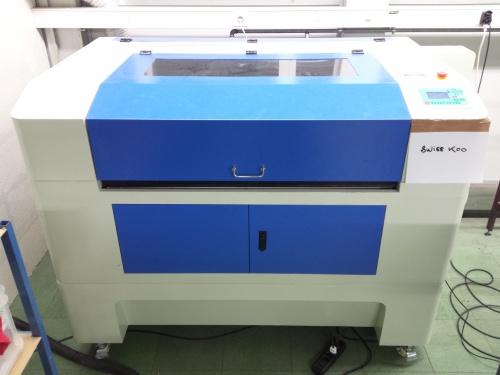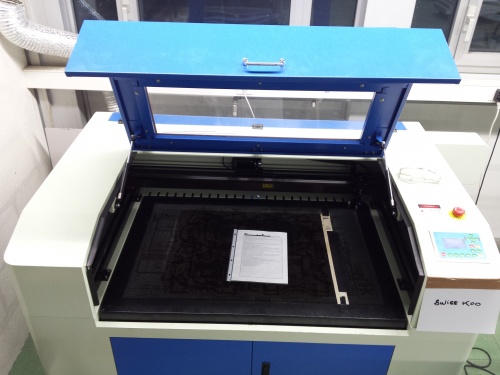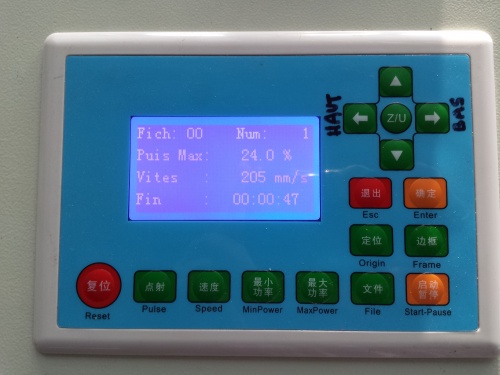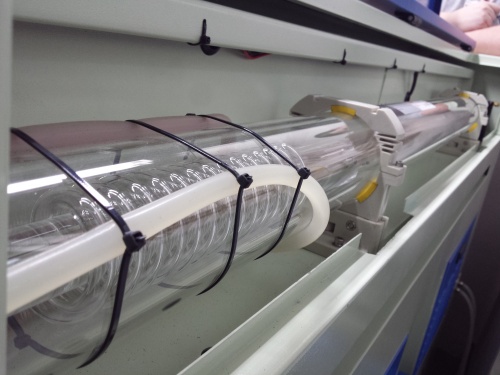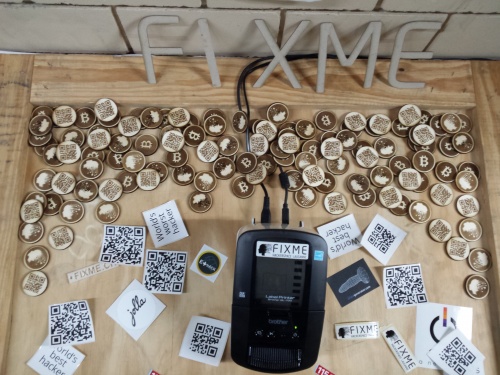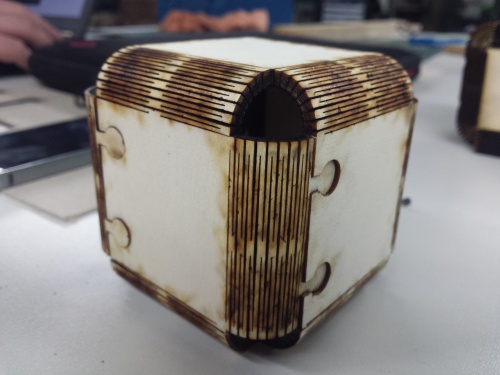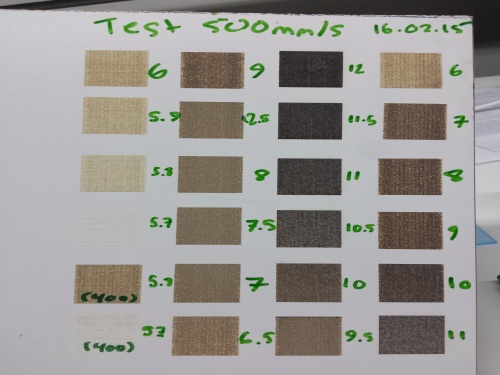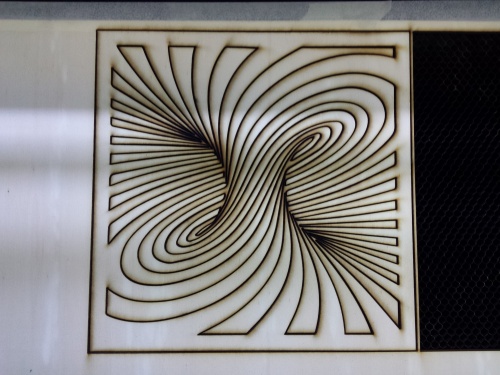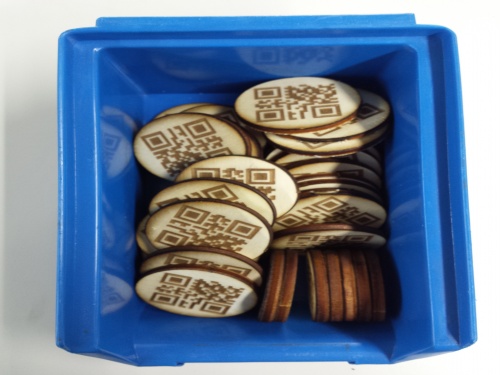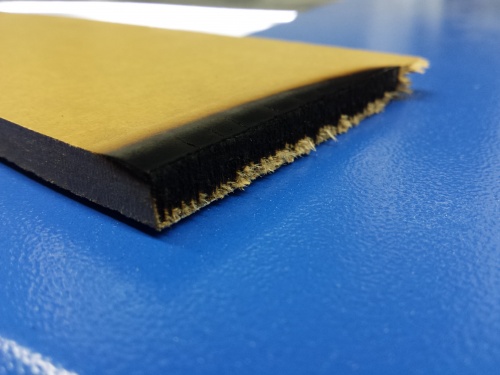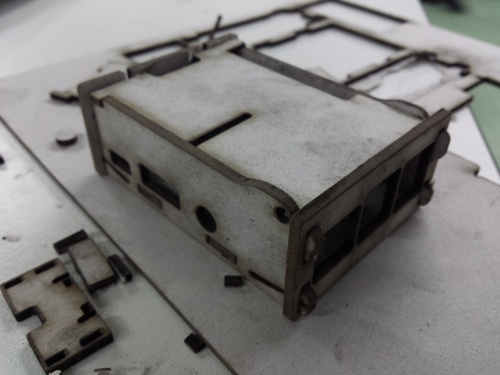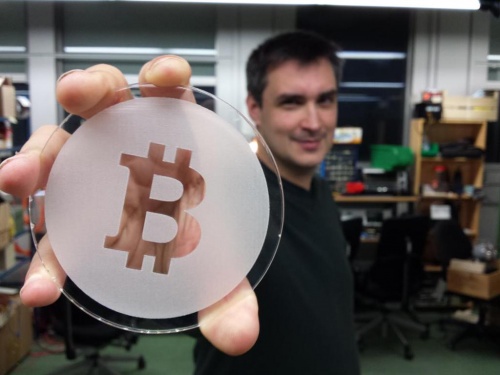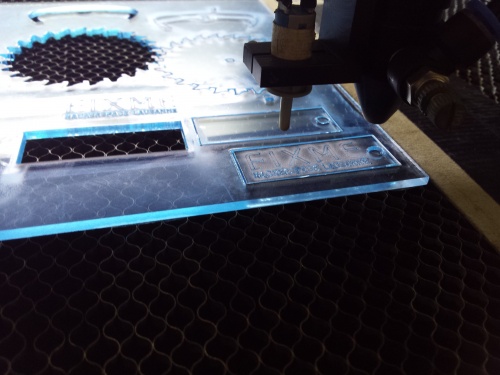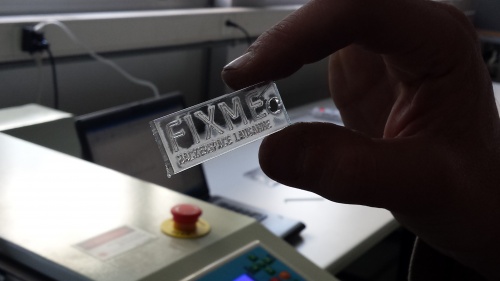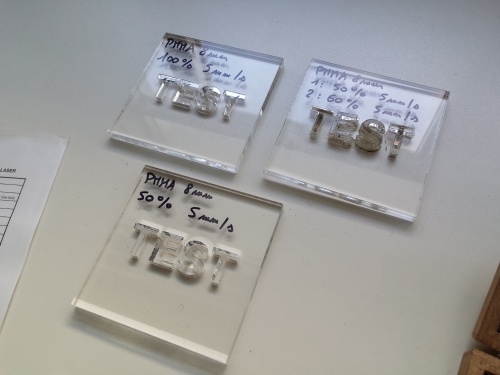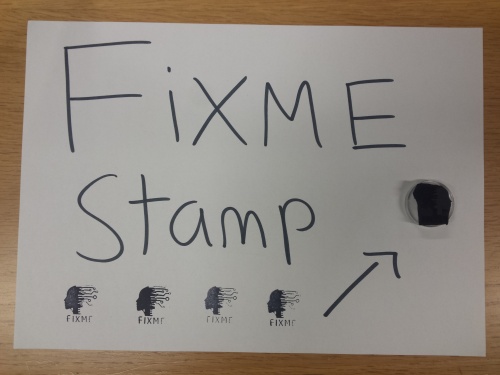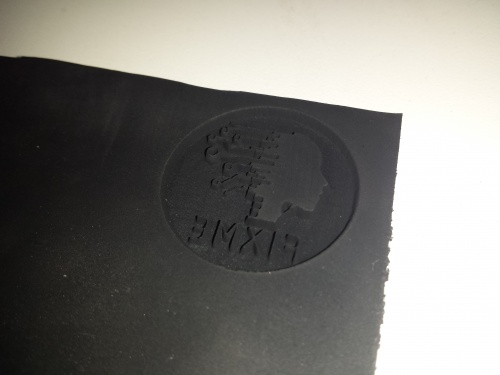Old makerspace laser cutter
Usage
- Step 0 - Turn on the laser cutter if you plan to use it, as it takes 5 minutes to warm up. Turn it on using the red and green buttons simultaneously on the right hand side.
- Prepare your file to cut or engrave. You'll need a .dxf file with all the paths stroked at 0.25px, with each different color of the paths representing different cut/engrave parameters. You can find such files by searching on Thingiverse and other related sites, or creating your own with software such as Inkscape, Illustrator, Inventor, or many others. Unfortunately many of the files you find online are in .ai, .pdf or .svg, you'll need to open them in one of these apps and export them to .dxf.
- Open the file in Laserworks. On the machine next to the laser cutter, plug in your USB key, and then import the .dxf via File > Import (ctr + i). If Laserworks says that it did not find any data, it means that you did not format your file correctly, or you used an incompatible file type. If you used illustrator, it may be due to having sublayers, which laserworks doesn't see.
- Scale and arrange your paths. Once you have imported your .dxf, the paths in the file will be shown in Laserworks. You can either select all of the paths, or select just one of them, and scale using the black arrows on the sides, or by changing the values in the scale toolbar on the top. It is also possible to move your paths by clicking and dragging the pink cross in the middle. You can group your paths using the group button on the top toolbar.
- Add or edit paths. You can do some basics edits in Laserworks with the toolbar on the left. If you want to cut/engrave your paths with different settings, you can set each paths' parameters by choosing a colour on the bottom toolbar. For example: you want to engrave a design, and cut a circle around it - so you set the design to red, and the circle to black.
- Select your engrave/cut parameters. On the top of the toolbar on the right, you'll see that each colour has its own parameters, and you can edit each one by double-clicking on it.
- Output Set to yes in order for your paths to cut/engrave (setting it to no could be useful if you have construction/instructional paths or you have multiple designs in the same file).
- Speed. See Materials section below to select the correct speed for cutting.
- Blowing. Set to yes, this is the internal air compressor that blows out of the mirror head.
- Processing mode. Set this first as all the following settings will depend on it. Cut will cut along the paths as a vector, scan will engrave between the lines of your paths, and dot will make a dotted outline of your paths.
- Power. See Materials section below to select the correct power.
- Ramp Effect. The exact use for this feature is unknown, however it is suspected that this can be used for stamps. Leave disabled.
- Overstriking. Sets how bold your scan will be - if left at Un-process, your scan (engraving) will be normal, if set to Intagilo, your scan will be bolder (wider/thicker edges), and if set to Rilievi, it will be lighter. It is best to leave it Un-processed.
- Scan mode. Only in scanning/engraving mode. Unilaterism mode will scan/engrave one line at each time the laser head passes, and swing mode will scan/engrave two lines at each pass, going in both directions. Uni mode gives better results but takes twice as long as swing mode. Set x if the paths are wider on the x scale than on the y scale, and choose y for when the paths are longer on the y scale - this optimises laser time.
- Interval. Only in scanning/engraving mode. Set the distance between each laser pass. 0.1mm is the minimum distance, and will produce results similar to a printer - but it takes a lot of time. 0.2mm is a good average, you can't really see the space between the passes. You can go up to 0.4mm before it starts to be somewhat visible.
- Interval > Advance. The cut after sweeping option allows you to make a contour along the edges of what you engraved. This can be useful for making letters clearer for example, however it can also make your job messier (especially if there are lots of small details). You can set the settings for this just like you would for a normal cut, however you can lower the power down to as little as 5.7% for a very light outline.
- Place your material into the laser cutter. See Materials below for a list of materials that you can use. It is recommended that you align your material as close to the upper left corner as possible, as that is where the laser is strongest.
- Make sure that the material is flat. Your cut/engrave will be of a lower quality if there is up to 0.5mm height difference, and your material may damage the laser machine if there is a 0.8mm or more height difference! Use yellow painting tape to stick it to the edges, or pick a different piece of your material if there is too much height difference.
- Align the mirror head. Laserworks cuts from the green square, so make sure that you align the mirror head to the top right side of your design on the material you're cutting, with the four blue arrow buttons on the laser machine. Measure out the total distance of your design (in laserworks, ctrl + a, then see the width and height in mm), and make sure that it doesn't go outside of your material and especially not outside of the cutting bed! You can use the 'Go scale' button to show you the outer dimensions of your cut without cutting on the laser machine.
- Align the height. There is an auto-focus feature on the laser, however unfortunately it is not currently functional due to a broken piece. Please see someone who knows how to use the laser to find out how to align the height correctly.
- Make a final check of everything. Make sure that there are no obstructions inside the laser machine, make sure that you've set all the correct cutting speeds and powers, and make sure that your cut/scan does not go outside of the borders of the cutting bed. If you want a preview of what the laser will do, select everything in Laserworks, and click the preview button on the top toolbar.
- Turn on the ventilation and close lid. Turn on the extraction fan by turning on the black powerstrip under the laser machine. Close the lid and put on your safety glasses.
- Start your cut/engrave!. After making sure that everything is good (and that you have the proper authorizations to use the laser machine), select everything you want to cut (ctrl + a), and press the 'Start' button in LaserWorks!
- Monitor the machine. Whilst the machine is working, you have to be nearby watching what it's doing!! If the material that you're cutting starts burning, immediately stop the cut, move the mirror head out of the way, and extinguish the fire with the fire blanket nearby (water will damage the machine). The renens fablab had their laser machine partially destroyed because someone went out to smoke whilst letting the laser cutter working - so pay attention!.
- After the machine has finished. When the job is finished, you will hear the laser beep three times, and you'll see the time on the small laser machine screen stop going up. Wait 30 seconds for the fumes to get extracted, and then proceed to open the lid. Make sure to remove all of the material from the machine - put the larger scraps on the shelves next to the machine for others to use, and throw away the smaller ones into the correct recycling bin. Remove any tape that remains, and move the mirror head to the top right side of the machine. Turn if off after leaving it to cool down for a few minutes (unless you're going to use it later in the day - it is best to leave it on in that case).
- Finish your pieces. Clean your completed pieces with compressed air (will get rid of all the carbon and dust accumulated), remove and protective tape, and optionally clean it with alcohol to remove any sediment (works great on both acrylic and wood).
- Leave the laser machine space as you found it. Remove your usb key, put all the things you used back into their places, and make sure that the place around the laser cutter is generally clean.
- Always cut with lid closed
- Always wear safety goggles
- Do not leave the laser cutter cutting without supervision
- Always cut with the ventilation system on (black power strip under laser cutter)
- Only use materials that are laser safe - see list below (TL;DR: never use PVC, don't cut metal)
- Be careful whilst using the control panel or the software to not start the laser by accident
- Be careful of the Pulse and Start-Pause buttons on laser cutter
- Be careful of the Start button on laser cutter software (particularly when resuming from standby..)
This section is work in progress
Design software
Inkscape
- Make sure object is vector (if you import a svg or make your own drawing, it will be already a vector; however png's and jpg's aren't vectors)
- Select object, then open the Trace Bitmap menu (Path > Trace Bitmap)
- Play with the various single scan options, and click 'update' to see a preview
- Convert the object to a path (Path > Object to Path)
- Set stroke (Object > Fill and Stroke) of object to 0.25px and no fill
- For every different layer you want to cut/engrave on the laser (aka engraved with different power for gradients), you must create a new color of the stroke
- Save as as dxf (you need python-lxml for this part, apt-get install python-lxml or pip install lxml (doesn't work out of the box on mac))
Illustrator
Basic instructions
- Getting started with Illustrator
- Make sure that all the things you want to cut/engrave are paths with a 0.25mm stroke and no fill
- Place all the paths into the root of a layer - Laserworks does not recognise sublayers, linked files or grouped paths
- Each color you select for your paths will show up as a different settings layer in Laserworks (e.g. black lines can be set to cut, red lines set to engrave). Any layers in Illustrator will be merged.
- File > Export as dxf, use R13/LT95 for the dxf format. Laserworks also supportes .ai files saved as Illustrator 8, but you may loose some editing functionality when saving with this, so be careful.
Text
- Select your text and remove the fill, then set a stroke of 0.25
- You must expand the text before importing it into Laserworks:
- When saving as dxf, select Outline Text
- Select text, then click Object > Expand. This will not allow you to edit the text afterwards, but works when saving as .ai
Bitmaps and images
- Drag your image into illustrator, and click on Image Trace (use the arrow on the right to find the best settings, or press the settings button to custom set the settings)
- Click the expand button
Outlines of shapes
Sticker tutorial but also applicable to laser cutting
Rhino
Used by Swisskoo and marc
Blender
Used by User:oenvoyage
- work with 2D bezier curves and add some extrusion (typically the width of your wood) while modeling your plates
- enable the Export Autocad DXF exporter Addon (File->User Preferences-> AddOn-> search DXF)
- before exporting: reduce the extrusion to 0, switch back your curves to 3D mode (Data panel-> shape-> 3D)
- Convert your bezier curves to Mesh (Alt-C)
- File -> Export -> Autocad (.dxf)
Somehow the DXF exported directly is not recognized by LaserWork, so you have to open it in Illustrator and save again as .dxf and make sure it's R13/LT95 format
Autodesk Inventor
Used by Swisskoo and User:Nemen
Export to .dxf
- Right-click on the face of your part you want to export.
- Choose "Export face as"
- Type the filename and click on Save
Laser software
The laser cutter is controlled by RDCam (version 5.2.06 installed on Atelier computer, other versions available on foo), it's manual is here File:Rdcam manual.pdf. When installing, you have to install it in 'demo mode', otherwise Laserworks won't open without a cutter connected (also don't forget to select english ;).
RDCam would not install in crossover (gui for wine), but feel free to try. Please note that .rld files created in different versions of the software are not inter-compatible unfortunately. This guy started reverse engineering the (scrambled) communications and .rld protocols, he has also managed to get it to work on wine.
Materials
Wood
4mm wood - 28-45mm/s @ 100% for cutting, depending on location on laser bed. 35 is a good average. Engraving is good at 500mm/s, you can engrave from 6% to 30-50-60% ish - this needs to be further clarified. 15-20% with a 0.2 interval gives a good clean result.
6mm wood - 20-30mm/s
Cardboard
40mm/s
Paper
No testing done yet
Acrylic
8-20mm/s, engraving at 20% 500mm/s
Rubber
- Focus laser at 6mm higher than usual (use two pieces of 3mm plexi)
- Engrave at 200mm/s, 20% and 0.2 unilat
- Do 6 passes total, changing the unilaterism between x and y for an even surface
- Clean surface with compressed air to remove the rubber dust between passes
- Stick rubber cut part onto a support material for when you want to make a stamp
Marc has bought A4 sheets at 57 CHF sheet, however here you can get them for 20$ per single sheet, or for 7$ here if you buy in lots of 5.
Mylar/thin plastic
This might be an interesting technique to try for thin plastics, such as those used for PCB stencils. The idea is that you have two layers of the material that you cut at the same time, the top one will be scrapped after, but the bottom one should be good - need to try this technique.
Others
There still needs to be extensive testing done to see which materials work and which don't, but basically the gist of it is: don't use anything that has PVC in it, and don't use metal (unless for engraving -> need to explore options). There have been some tests with rubber (for stamps) as well, this needs to be properly documented and more testing needs to be done.
NEVER CUT THESE MATERIALS
WARNING: Because many plastics are dangerous to cut, it is important to know what kind you are planning to use. Make has a How-To for identifying unknown plastics with a simple process.
| Material | DANGER! | Cause/Consequence |
|---|---|---|
| PVC (Poly Vinyl Chloride)/vinyl/pleather/artificial leather | Emits pure chlorine gas when cut! | Don't ever cut this material as it will ruin the optics, cause the metal of the machine to corrode, and ruin the motion control system. |
| Thick ( >1mm ) Polycarbonate/Lexan | Cut very poorly, discolor, catch fire | Polycarbonate is often found as flat, sheet material. The window of the laser cutter is made of Polycarbonate because polycarbonate strongly absorbs infrared radiation! This is the frequency of light the laser cutter uses to cut materials, so it is very ineffective at cutting polycarbonate. Polycarbonate is a poor choice for laser cutting. |
| ABS | Emits cyanide gas and tends to melt | ABS does not cut well in a laser cutter. It tends to melt rather than vaporize, and has a higher chance of catching on fire and leaving behind melted gooey deposits on the cutting grid. It also does not engrave well (again, tends to melt). |
| HDPE/milk bottle plastic | Catches fire and melts | It melts. It gets gooey. Don't use it. |
| PolyStyrene Foam | Catches fire | It catches fire, it melts, and only thin pieces cut. This is the #1 material that causes laser fires!!! |
| PolyPropylene Foam | Catches fire | Like PolyStyrene, it melts, catches fire, and the melted drops continue to burn and turn into rock-hard drips and pebbles. |
| Fiberglass | Emits fumes | It's a mix of two materials that cant' be cut. Glass (etch, no cut) and epoxy resin (fumes) |
| Coated Carbon Fiber | Emits noxious fumes | A mix of two materials. Thin carbon fiber mat can be cut, with some fraying - but not when coated. |
List from ATX hackerspace's wiki
Hardware
According to cononelmoutarde (Marc/Workshop Ninja), the laser cutter is a Keyland Laser 1060.
Search terms: Ebay 100w laser or just 100w laser - it's a generic design (3500~4000 usd for laser cutter with/without shipping depending on source, ~1000 usd for laser tube with shipping). RD-ACS controller (generic controller so used in lots of laser cutters).
Photos
Wood
Cardboard
Acrylic
Rubber
Others

